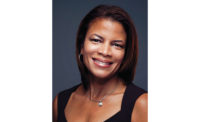Newsmaker: Toni L. Griffin
The noted urban planner is heading up the new Bond Design Center at the City College of New York.
 |
| Photo courtesy CCNY |
Griffin is heading up the recently launched J. Max Bond Center on Design for the Just City. |
Architect and urban planner Toni L. Griffin has introduced progressive ideas to mainstream planning over her 25-year career. Her test beds have included Detroit, where she has dealt with depopulation strategies, and Newark, where she worked to spur job growth. Earlier, she held positions with the District of Columbia and Upper Manhattan Empowerment Zone Development Corporation, in addition to Skidmore, Owings & Merrill.
Now, Griffin is heading up the new J. Max Bond Center on Design for the Just City at the City College of New York (CCNY), located in Harlem. The new center, housed within the Spitzer School of Architecture, is named after the late architect Max Bond, who served as the school’s dean from 1985 to 1992. Griffin will continue her private practice while shaping the goals and efforts of the new center. Architectural Record recently spoke with Griffin about her latest undertaking.
DS: What prompted you to join CCNY?
TG: The opportunity to launch the Bond Center. I first met Max through the pages of African American Architects in Current Practice, a 1991 book edited by Jack Travis. I was at SOM at the time [where she was an associate principal], and the fact that Max was an African American designer and a partner of a major firm impressed me. I met him 10 years later, and he ended up being a great adviser.
DS: How would you describe the center’s mission?
TG: To advance design through research, practice, and education. We intend to work on projects that incorporate two or more disciplines and can impact a community, city, and region simultaneously. I also want the work to be transferable: How can we extract lessons from one location and apply them elsewhere?
DS: Will Harlem be a testing ground?
TG: We’ll consider projects in our own backyard, but I don’t want to be limited by our immediate context.
DS: I hear your students are already developing neighborhood “sustainability indicators” in Newark.
We have partnered with the Jonathan Rose Companies. Before I left my post in Newark, we wrote a contract with Jonathan Rose to have a planning team complete the long-range master plan for the city; I have three students working with them now. We’re developing a tool to measure sustainability indicators specific to Newark, but we’re also going to create a more standardized tool to measure a city’s physical, environmental, and social sustainability.
DS: How does your work in the public and private sectors benefit your academic pursuits?
TG: The pace and urgency in the political process don’t allow you to be as experimental as you’d like. Teaching gives me the opportunity to step back and challenge that. At the same time, it’s good to bring the realities of practice into the academic setting.
DS: There are a number of thought institutions that are increasingly looking at planning reform. Where does the Bond Center fit into that trend?
TG: I love the fact that there is an exhibition at MoMA focusing on issues of the “just city” [Foreclosed: Housing the American Dream]. I’m a full supporter of broadening this conversation, and I hope the center can participate in that discourse in ways that reach many audiences, including people who don’t necessarily speak the way we do. It’s important for the center to take on both real and speculative projects.
DS: What is the most critical issue facing cities today? How do we create a “just city”?
TG: Increasingly, I find that we must confront how we understand and talk about race and class in planning and design.
DS: Will the Bond Center also focus on diversity among architecture students?
TG: My long-term vision is to create an academy that raises design awareness among youth of color. As we devise interventions that move toward the “just city”—if we define the just city as being inclusive and equally accessible—then architects must reflect that approach.
A version of this story appears in our June 2012 issue.


